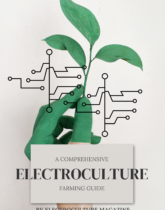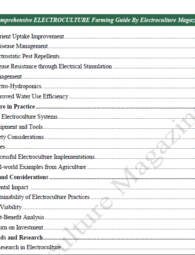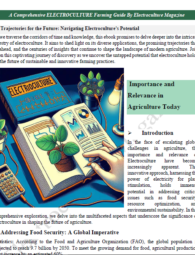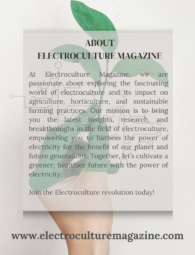Welcome to Electroculture Magazine, your ultimate destination for all things electrifying in the world of agriculture! We are thrilled to present an enthralling blog post that dives deep into “The History of Electroculture.” Prepare to embark on a captivating journey through time as we unravel the fascinating origins and evolution of this revolutionary farming technique.
From its humble beginnings to its remarkable impact on crop productivity and sustainability, we’ll explore the pioneers, breakthroughs, and transformative applications that have shaped electroculture. Join us as we unlock the secrets of harnessing electricity’s power to revolutionize the way we cultivate our planet. Get ready to be enlightened and inspired by the electrifying story of Electroculture!
Relevance for History of Electroculture
Believe it or not, electroculture’s story begins long before smartphones and self-driving tractors. Picture this: it’s the late 18th century, a time when the world was still mesmerized by the discovery of electricity. Pioneers like Luigi Galvani and Alexander Volta were at the forefront, tinkering with electrical currents and their effects on living organisms. Little did they know, their experiments were planting the seeds for electroculture’s journey.
Fast forward to the 20th century, and electroculture starts gaining a bit more traction. In the 1930s, a visionary Frenchman named Albert Brault took a bold step and patented a method involving mild electrical currents applied to plant roots. Brault believed that these currents could supercharge nutrient absorption and plant growth. But here’s the twist – his ideas didn’t exactly send shockwaves through the farming community. The concept fizzled out, tucked away in the pages of history.
Let us now fast forward to our digital age, when curiosity meets technology. With the advent of sustainable and creative agricultural practises in the twenty-first century, electroculture was given a second opportunity in the limelight. Farmers, scientists, and backyard experimenters banded together, eager to capitalise on electricity’s potential to transform agriculture.
What is their goal? To increase agricultural yields, reduce pesticide use, and promote soil health.
But, like with every fantastic narrative, there are some who are sceptical. Some criticise electroculture’s consistency and scientific support. It’s like predicting the weather for tomorrow – it’s hit or miss. While some research have yielded encouraging findings, the dispute continues and a consensus remains elusive.
In a world where technology meets the soil, electroculture stands as a testament to human curiosity and innovation. So, there you have it, pals – the early history of electroculture, from Galvani’s sparks to Brault’s current ideas, all the way to our modern-day agricultural renaissance. Thanks for plugging into today’s read, and remember, the journey from electrons to exceptional crops is still one of farming’s most electrifying adventures!
French History of Electroculture
Georges Lakhovsky, a French engineer, was one of the first proponents of electroculture. During his tests with high-frequency electromagnetic waves on plants in the 1920s and 1930s, he saw improved growth and disease resistance. The electrical charge, in Lakhovsky’s opinion, stimulated the plant’s cells and made them more resistant to pests and illnesses.
Other researchers were motivated to investigate the potential advantages of electroculture by Lakhovsky’s work. Soviet researchers claimed considerable production gains in the 1950s after conducting trials in which they applied electrical currents to crops including wheat and corn. The electrical charge, according to Soviet scientists, stimulated the roots of the plants, increasing their capacity to absorb water and nutrients from the soil.
Other History of Electroculture
Back in the day, after Luigi Galvani and Alexander Volta stirred the pot with their electrical experiments on living organisms in the late 18th century, a spark of interest emerged in the agricultural realm. Scientists in the US and around the world took up the mantle of exploring electroculture, subjecting plants and soil to gentle electrical currents. The results, as you might expect, varied like the weather.
Through the following decades, researchers on this electrifying quest reported mixed findings. While some studies found no significant effects of electrical currents on crops, others excitedly announced noteworthy increases in yields. It was like trying to predict whether your summer barbecue would be a washout or a sun-soaked celebration – you couldn’t quite tell what the outcome would be. Yet, despite these differing outcomes, the scientific community largely remained skeptical. Many experts waved electroculture off as mere pseudoscience, akin to chasing rainbows in a science lab.
Fast-forward to the groovy 1970s and 80s – a time of energy crises and mounting environmental concerns. Suddenly, electroculture regained the spotlight, championed by forward-thinking researchers seeking sustainable farming methods. The world was realizing that the conventional practices of agriculture were leaving a sizable carbon footprint, and alternative solutions were urgently needed. This is where our protagonist, Robert C. Beck, strides onto the scene.
Beck, stationed in California, emerged as one of the driving forces behind the revival of electroculture. Through a series of carefully designed tests, he electrified a variety of crops: tomatoes, strawberries, and maize. And boy, did the plants respond! Yield increases were the name of the game, thanks to the electrifying charge that seemed to awaken the roots. Beck believed that this shock to the system boosted the plants’ ability to suck in water and nutrients from the soil.
Now, while the buzz around electroculture gained momentum, a cloud of doubt lingered in the scientific skies. Some researchers argued that reproducing the results of electroculture studies was about as unpredictable as forecasting the lottery numbers. The variables in play were like the ever-shifting winds that can catch even the savviest meteorologist off guard. Furthermore, the exact science behind how electroculture worked remained shrouded in mystery, leaving many skeptical brows furrowed.
In the grand symphony of science, electroculture still occupies a seat at the back, waiting for its defining solo. While proponents cheer for its potential to revolutionize agriculture – reducing water usage, curbing chemical dependency, and boosting yields – critics caution against jumping on the electro-hype train too hastily.
The current landscape (pun intended) of electroculture is a delicate balance between enthusiasm and caution. Researchers are plugging away, delving into the intricacies of electrical currents and plant growth, hoping to illuminate the path forward. It’s like navigating through uncharted territory – you’re not quite sure where you’ll end up, but the adventure is alluring.
Recent Trends
Recent technological advancements and a rising understanding of the effects of traditional agriculture on the environment have helped to rekindle interest in electroculture. Electroculture proponents claim that by using less water and fertilizer, producing more crops, and enhancing soil quality, their method has the potential to transform agriculture. Scientists have recently started to investigate electroculture’s potential as a solution to the problems of climate change and food security, which has sparked a resurgence in interest in the field.
In recent years, electroculture has been experiencing a revival like never before. With sustainability becoming a top priority in farming, innovative techniques are stealing the limelight. Enter electroculture, a concept that’s been around for ages but is making a comeback in the age of smart farming and eco-consciousness.
Picture this: farmers across the country are experimenting with applying low-voltage electrical currents to their crops and soil. The idea is to stimulate plant growth, enhance nutrient uptake, and reduce the need for chemical fertilizers. It’s like giving your plants a gentle wake-up call, encouraging them to reach their full potential without relying on harsh chemicals.
But what’s different this time around? Technology, my friends. We’re not just talking about a couple of wires hooked up to a plant. Advanced sensors, precision monitoring systems, and data analytics are now part of the electroculture landscape. Farmers can now fine-tune the electrical pulses based on real-time data, soil conditions, and plant health. It’s like personalized electricity for your plants – a true match made in agri-tech heaven.
Now, let’s talk benefits. One of the most exciting trends is the potential for reduced environmental impact. Electroculture’s promise of decreasing chemical usage aligns perfectly with the global push for sustainable farming practices. Plus, imagine the economic savings for farmers when they can cut down on costly fertilizers.
However, let’s not get too starry-eyed. Electroculture isn’t without its skeptics. Some experts are cautious, citing the need for more robust scientific evidence before embracing it wholeheartedly. The variability in results and the intricate dance between electricity and plant biology are still being understood.
In a nutshell, electroculture’s recent trends are a captivating blend of tradition and innovation. It’s like our ancestors’ experiments with a 21st-century twist. Whether electroculture becomes the new normal or a passing fad remains to be seen, but one thing’s for sure – the conversation around it is charged with excitement and potential. So, there you have it, folks – the electrifying scoop on electroculture’s latest trends. Until next time, keep those ideas sparking and your plants thriving!
Recent research has demonstrated that electroculture may be utilized to boost crop yields in a range of challenging situations, including as drought, heat stress, and nutrient deficit. Another strategy being investigated to increase crops’ resistance to pests and diseases is electroculture.The history of electroculture demonstrates that electrical currents may significantly affect the growth and development of plants. A cutting-edge technique for growing plants called electroculture has the potential to boost agricultural production and enhance plant health.
However, skeptics continue to be wary, claiming that more research is necessary to fully comprehend the advantages and disadvantages of electroculture. Despite the controversy surrounding it, electroculture is still a fascinating idea that has intrigued both farmers and scientists.
Also learn about Electroculture Gardening…












